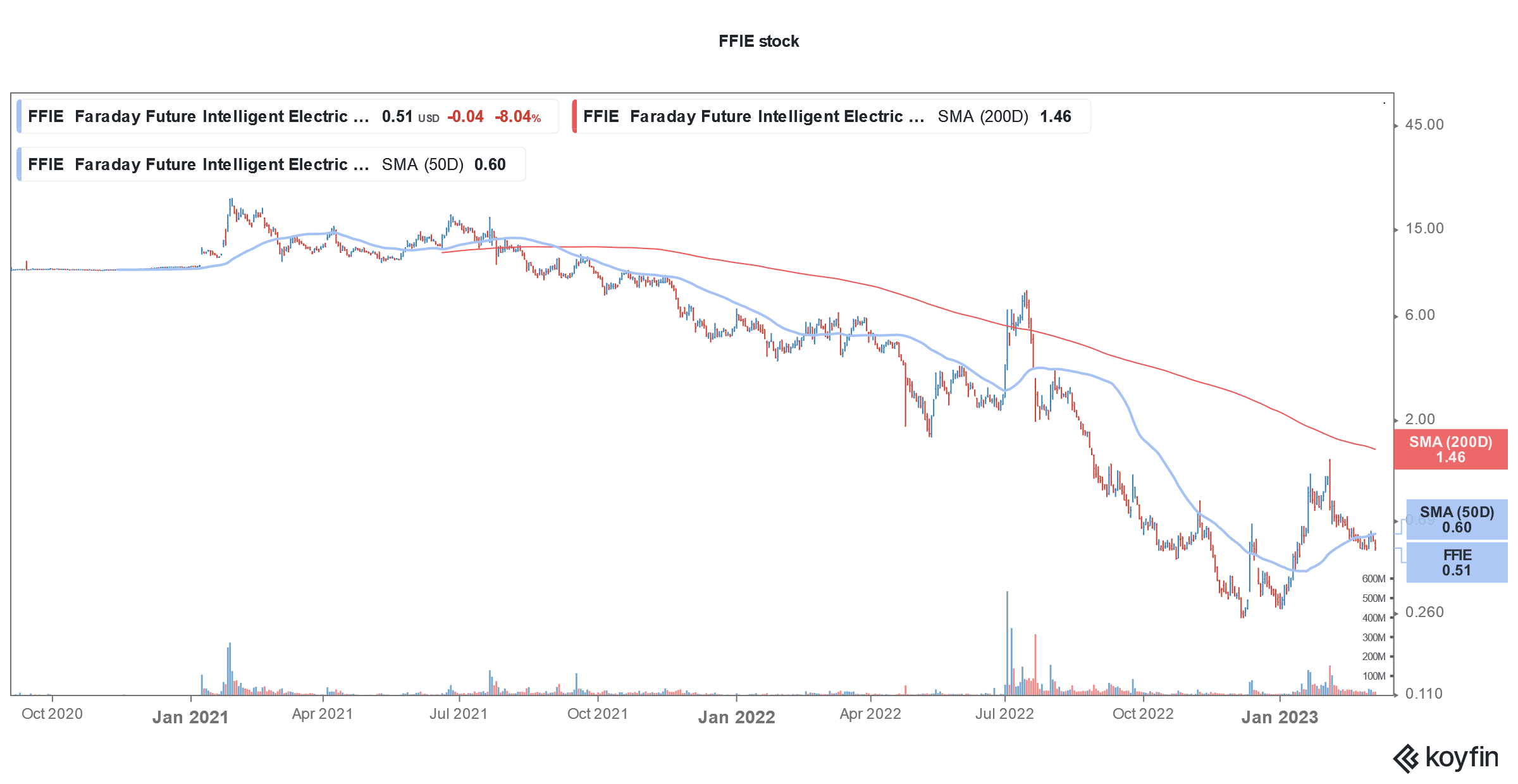Faraday Future Commits to March Production Deadline with a Caveat
Please note that we are not authorised to provide any investment advice. The content on this page is for information purposes only.
Faraday Future (NYSE: FFIE) has said that it would begin production of its FF 91 Futurist car by the end of March. However, the SOP (start of production) is contingent on it receiving the previously announced funds.
Faraday Future released its earnings for the fourth quarter of 2022 and the full year yesterday after the markets closed. It reported operating expenses of $451 million in the year as compared to $354.1 million in the previous year.
Faraday Future lost $552.1 million last year which was wider than the 2021 loss of $516.5 million. During the year, it reported negative operating cash flows of $383.1 million while the capex for the year stood at $123.2 million.
It ended the year with cash and restricted cash of $18.5 million. In 2023, the company announced a $135 million convertible note offering of which it received $70 million.
Faraday Future commits to the March production timeline with a caveat
In its release, Faraday Future said, that it “is targeting a SOP date for its flagship FF 91 Futurist of March 30, 2023, assuming timely receipt of funds from the Company’s investors and suppliers meeting our supply chain requirements, at the Company’s Hanford, California manufacturing facility.”
It also expects to begin deliveries before the end of April. In his prepared remarks, Xuefeng Chen, Global CEO of Faraday Future Future said, “Securing the necessary funding commitments to begin production and delivery of this vehicle is a major game changer for us. Going forward, we expect to utilize all available resources in order to deliver our car to our enthusiastic customers.”
Faraday Future production is running behind schedule
When Faraday Future went public in 2021 it said that it expects to begin production in the next 12 months. It had then said that over the next three years, it would launch new models including a lower-priced electric car.
However, like many startup EV companies like Nikola and Lordstown Motors, Faraday Future is also running behind schedule. Nikola began production last year but could only deliver 20 trucks to dealers in the fourth quarter.
Lordstown Motors sold its plant to Foxconn which now makes cars on contract manufacturing. The company has only delivered a handful of its Endurance pickups and has had to do a recall. It has also paused production over quality issues.
Also, startup EV companies including Faraday Future are battling perennial cash burn and need a constant infusion of cash.
EV companies are facing troubles
Most startup EV companies including Lucid Motors and Rivian have faced execution issues since they went public.
Lucid Motors expects to produce between 10,000-14,000 cars in 2023. The guidance is even lower than its original 2022 guidance. Also, it would imply a production run rate similar to the fourth quarter of 2022.
Lucid Motors reported a total reservation of over 28,000 during the Q4 2022 earnings call. During the Q3 2022 earnings call, the company said it has 34,000 reservations while the figure was 37,000 in the previous quarter. LCID’s reservations have now dropped for two consecutive quarters.
The company would also now stop providing the reservation number and said that the current reservations are a revenue opportunity of $2.7 billion. Here it is worth noting that the reservations do not include the upto 100,000 vehicles that Saudi Arabia could order from the company.
During the earnings call, Lucid Motors’ CEO Peter Rawlinson emphasized multiple times that the company is no longer constrained by production unlike in 2022 when supply chain bottlenecks took a toll on its production.
Lucid Motors might be facing demand issues
The company also stressed that it has the capacity to produce more cars in the year. Lucid Motors guidance meanwhile baffled many analysts as despite having reservations twice its guidance’s upper end, the company is not scaling up production.
Lucid Motors said that firstly the reservations are not binding and secondly it is being prudent with the guidance considering the macroeconomic slowdown. The company’s CFO Sherry House added, that some of “the reservation holders are “waiting for us to offer their very specific configurations in volume.”
Rivian also guided for a 2023 production of 50,000 which was below estimates. The company meanwhile said that its production is still limited by supply chain issues.
Faraday Future went public in 2021
Rivian, Lucid Motors, Faraday Future, and Nikola are among the many EV startups that went public between 2020 and 2022 There was euphoria toward EV names in 2020 and 2021 and Tesla stock rose 740% and 50% respectively in 2020 and 2021.
Faraday Future too went public through a SPAC reverse merger in 2021 and raised $1 billion. It now trades at around 50 cents while the SPAC IPO price was $10. Faraday Future’s current market cap of $352 million is a fraction of its all-time highs.
Meanwhile, the company continues to burn cash and during the earnings call, it revealed another capital raise program. During the earnings call, Faraday Future CFO Yun Han said, “We have just begun a $50 million raise to have better liquidity to support our production ramp and have already received indications of interest from investors for nearly the full amount.”
Notably, Rivian, which had cash and cash equivalents of $11.6 billion at the end of 2022 also recently announced a $1.3 billion convertible note issue.
Along with execution and cash burn issues, startup EV companies are also battling frequent price cuts from Tesla. As the demand growth for electric cars slows and competition rises further, companies like Faraday Future seem to have a bumpy road ahead.






